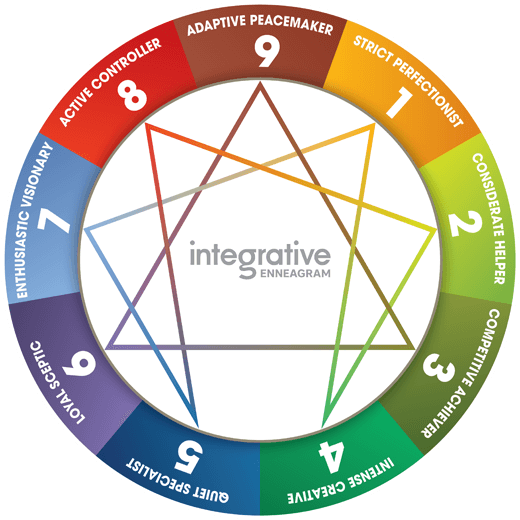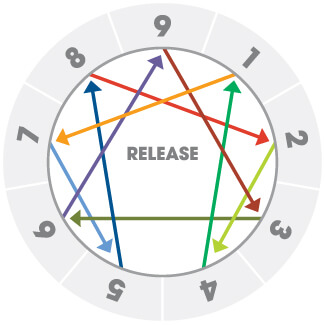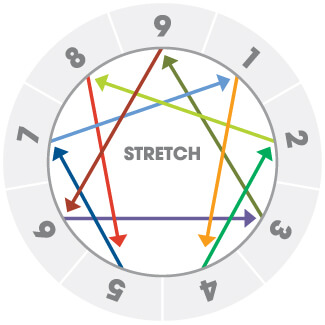The Enneagram is much more than nine points on an intersection of a triangle and a hexagon or a set of categories or types to be 'sorted into'. It is a psycho-dynamic framework that provides a powerful model for understanding how development and integration operate.
The Enneagram does not provide a 'quick fix' with a limited lifespan once insight has been reached. It enables people to develop themselves over time as the Enneagram continues to speak to us as we and our circumstances change.
Within the framework, the wings, instincts, levels of integration and lines represent the movement and journey we are on in life. The gift of the Enneagram is the richness of potential and movement it offers, flexing between core type, wings and line of release and connection, and levels of integration, to more fully exploring one's being.
There are three fundamental ways of looking at movement within the Enneagram:
Moving around the circle to connect to points on either side of your core type, 'close neighbours'.
Read More about Enneagram WingsMovement to connected points across the circle, your points of 'stretch and release'.
Read More about Enneagram LinesMovement from a 'trapped' relationship to our core type to letting go of core fears and transcending the limitations of type.
Read More about Levels of IntegrationThe Enneagram is described in a series of lines of movement or influence. These lines indicate the influences and interactions between Enneagram types, patterns of energy movement or flow. While our core type remains constant as a 'home base', we are also capable of travelling, or even being pulled, along these connecting lines. Each Enneagram type or number is related to those on the other end of the line, as a polarity or paradox to be lived into.
Moving along the lines offers a significant shift in perspective or point of view, which allows us to step out of our typical style and reactions and create new ways to respond to the world around us. The lines, therefore, offer rich potential for exploration and development as they offer balance and fresh resources to our core type. Ideally we work to develop the ability to be fluent in the lines as a continuum, as a path of movement for our integrated self.
Here is the main thing: the lines are the basic building blocks of the Enneagram, not the points. An Enneagram line is an archetype, a collection of themes, like a novel or a life. These themes are meant to be engaged, participated in, and wrestled with. Michael Goldberg Enneagram Author

The line pointing away from one's core type can be seen as the direction of security, possibility or release. Moving along this line allows us to explore the higher aspects of the connected type, opening the doorway to increased health, self-actualisation and the release of stress.

EXAMPLE: If a Two under pressure is able to connect to the positive or higher characteristics of the Four, such as connecting to their own emotions and needs, creative expression, process-awareness and discernment, they are able to step into a different way of being, get a different perspective on their situation and find some release from their stress and internal conflict
The line pointing towards one's core type can be seen as the direction of stretch, challenge or stress. Under pressure, you may revert to the 'lower' or less-healthy aspects of this type, opening the doorway to potential unhealthy expression, neurosis and the magnification of stress. However, an intentional move to the high or positive side of that type may create positive stress and stretch, balancing the less-effective tendencies or reactions of the core type.

EXAMPLE: If a Two consciously accesses the high side of the Eight, intentionally stepping out of their comfort zone and connecting to their personal power, expressing anger directly and appropriately and worrying less about how others react. For an overburdened 'helper' Two, experiments in this direction may be powerfully developmental and help stuck clients become unstuck.
The Levels of Integration or Levels of Development refer to the degree of self-mastery individuals have achieved so far in their personal development journeys in life. This is a time-bound measure and will change as people invest in their personal growth, but also as their circumstances become more or less challenging.
While integration is not fixed, and people may move between high and low integration behaviours depending on context, more people demonstrate a concentration of energy and behaviour at a particular level of integration over time.
At a high level of integration one moves towards the Center of the Enneagram, able to 'play' in the wings, the lines of stretch and release, holding your core type more lightly and fluidly. This tends to moderate the core motivations, behaviours, themes and fears of an individual's main Enneagram type significantly and so individuals at high integration may be more challenging to type definitively.
The Integrative Enneagram Questionnaire broadly measures self-mastery according to three levels of integration. Even though all people may move between high and low integration behaviours depending on their context and level of strain, there is likely to be a concentration of energy and behaviour at a particular level of integration at any given point in time.
